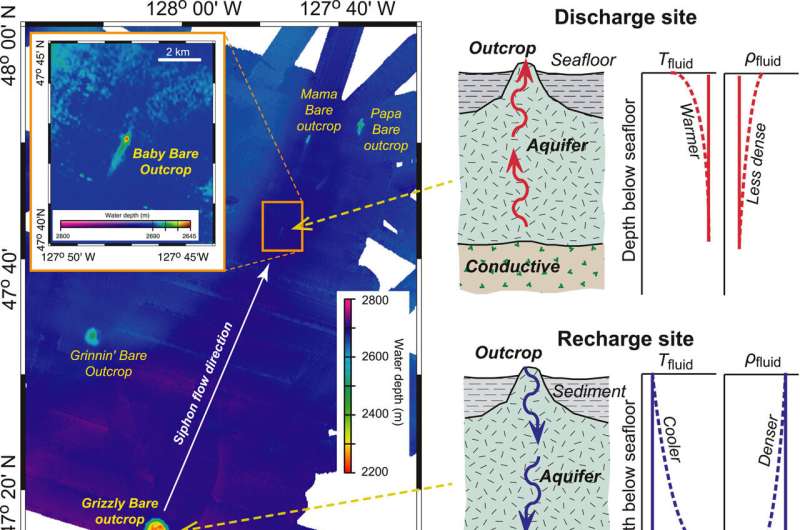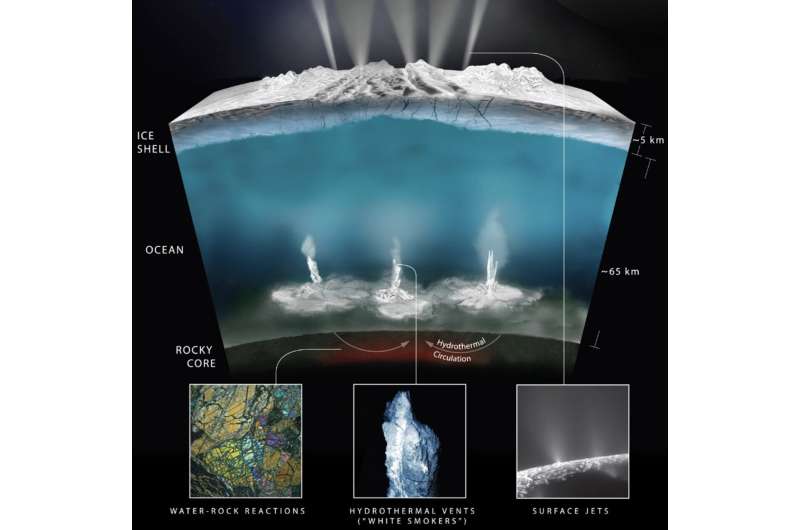This article has been reviewed according to Science X's editorial process and policies. Editors have highlighted the following attributes while ensuring the content's credibility:
fact-checked
peer-reviewed publication
trusted source
proofread
Hydrothermal vents on seafloors of 'ocean worlds' could support life, new study says

We've all seen the surreal footage in nature documentaries showing hydrothermal vents on the frigid ocean floor—bellowing black plumes of super-hot water—and the life forms that cling to them. Now, a new study by UC Santa Cruz researchers suggests that lower-temperature vents, which are common across Earth's seafloor, may help to create life-supporting conditions on "ocean worlds" in our solar system.
Ocean worlds are planets and moons that have—or had in the past—a liquid ocean, often under an icy shell or within their rocky interior. In Earth's solar system, several of Jupiter's and Saturn's moons are ocean worlds, and their existence has motivated everything from peer-reviewed academic studies and spacecraft missions with satellites, to popular movies like the 2013 sci-fi thriller, The Europa Report.
Many lines of research suggest that some ocean worlds release enough heat internally to drive hydrothermal circulation under their seafloors. This heat is generated by radioactive decay, as occurs deep in the Earth, with additional heat possibly generated by tides.
Rock-heat-fluid systems were discovered on Earth's seafloor in the 1970s, when scientists observed discharging fluids that carried heat, particles, and chemicals. Many vent sites were surrounded by novel ecosystems, including specialized bacterial mats, red-and-white tubeworms, and heat-sensing shrimp.
Simulating alien seafloors
In this new study, published today in the Journal of Geophysical Research: Planets, the researchers used a complex computer model based on hydrothermal circulation as it occurs on Earth. After changing variables like gravity, heat, rock properties and fluid-circulation depth, they found that hydrothermal vents could be sustained under a wide range of conditions. If these kinds of flows occur on an ocean world, like Jupiter's moon Europa, they could raise the odds that life exists there as well.
"This study suggests that low temperature (not too hot for life) hydrothermal systems could have been sustained on ocean worlds beyond Earth over timescales comparable to that required for life to take hold on Earth," said Andrew Fisher, study lead author and a distinguished professor of Earth and planetary sciences (EPS) at UC Santa Cruz.

The seawater-circulation system that the team based their computer models on was found on a 3.5 million-year-old seafloor in the northwestern Pacific Ocean, east of the Juan de Fuca Ridge. There, cool bottom water flows in through an extinct volcano (seamount), travels underground for about 30 miles, then flows back out into the ocean through another seamount. "The water gathers heat as it flows and comes out warmer than when it flowed in, and with very different chemistry," explained Kristin Dickerson, the paper's second author and a Ph.D. candidate in Earth and planetary sciences.
The flow from one seamount to another is driven by buoyancy, because water gets less dense as it warms, and more dense as it cools. Differences in density create differences in fluid pressure in the rock, and the system is sustained by the flows themselves—running as long as enough heat is supplied, and rock properties allow enough fluid circulation. "We call it a hydrothermal siphon," Fisher said.
Earth's cooling system
While high-temperature vent systems are driven mainly by sub-seafloor volcanic activity, Fisher explained that a much larger volume of fluid flows in and out of Earth's seafloor at lower temperatures, driven mainly by "background" cooling of the planet. "The flow of water through low-temperature venting is equivalent, in terms of the amount of water being discharged, to all of the rivers and streams on Earth, and is responsible for about a quarter of Earth's heat loss," he said. "The entire volume of the ocean is pumped in and out of the seafloor about every half-million years."
Many previous studies of hydrothermal circulation on Europa and Enceladus, a small moon orbiting Saturn, have considered higher temperature fluids. Cartoons and other drawings often depict systems on their seafloors that look like black smokers on Earth, according to Donna Blackman, an EPS researcher and third author on the new paper. "Lower-temperature flows are at least as likely to occur, if not more likely," she said.
The team was particularly excited about one result from the computer simulations featured in the new paper showing that, under very low gravity—like that found on the seafloor of Enceladus—circulation can continue with low to moderate temperatures for millions or billions of years. This could help to explain how small ocean worlds can have long-lived fluid-circulation systems below their seafloors, even though heating is limited: the low efficiency of heat extraction could lead to considerable longevity—essentially, throughout the life of the solar system.
Planetary scientists are looking to observations from satellite missions to help determine what kinds of conditions are present or possible on ocean worlds. The authors of the new paper plan to attend the launch of the Europa Clipper spacecraft later this fall at Cape Canaveral, Fla., along with colleagues collaborating on the Exploring Ocean Worlds project.
The researchers acknowledge the uncertainty of when the seafloors of ocean worlds will be directly observed for the presence of active hydrothermal systems. Their distance from Earth and physical characteristics present major technical challenges for spacecraft missions. "Thus, it is essential to make the most of available data, much of it collected remotely, and leverage understanding from decades of detailed studies of analog Earth systems," they conclude in the paper.
More information: A. T. Fisher et al, Sustaining Hydrothermal Circulation With Gravity Relevant to Ocean Worlds, Journal of Geophysical Research: Planets (2024). DOI: 10.1029/2023JE008202
Journal information: Journal of Geophysical Research
Provided by University of California - Santa Cruz



















